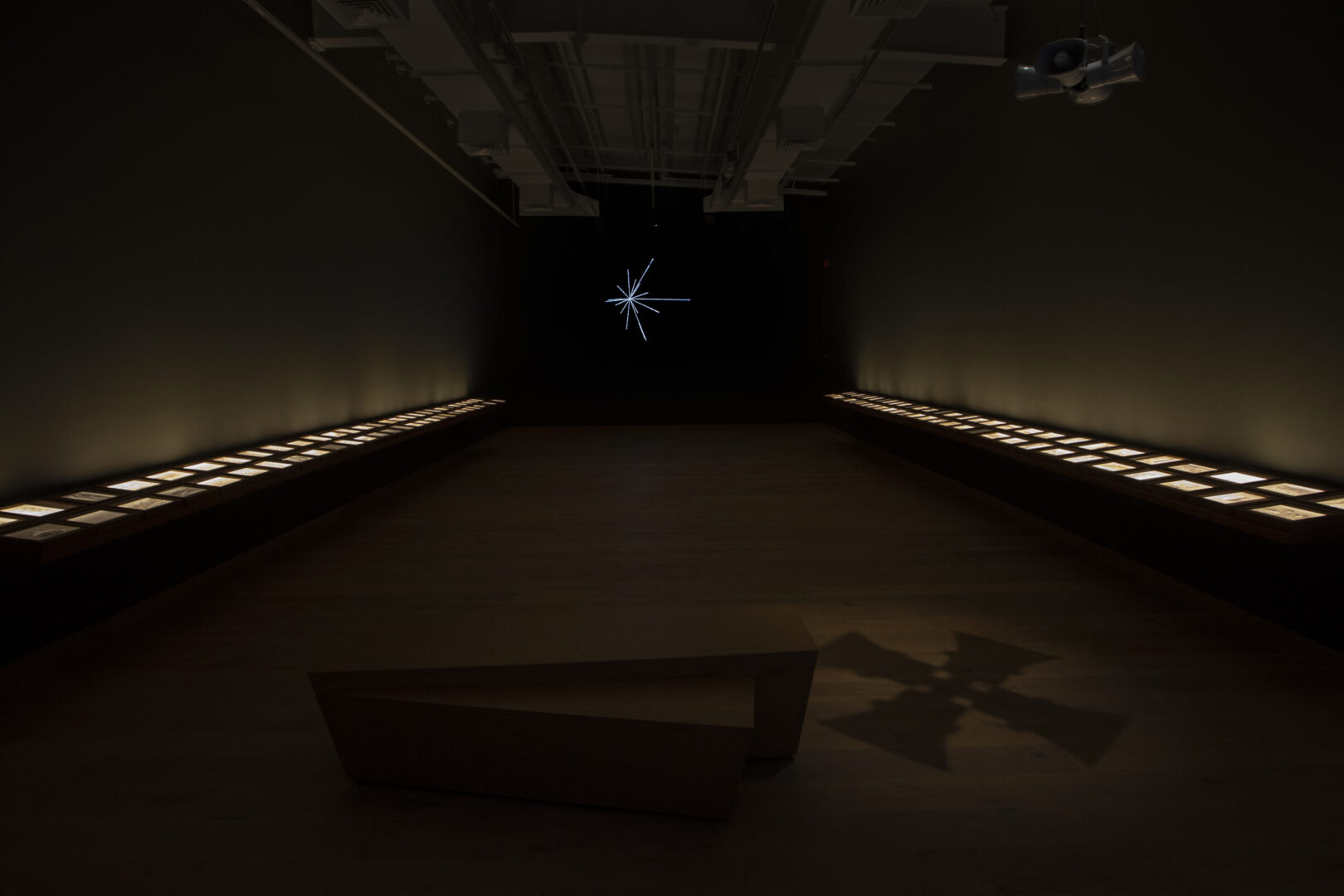SAN FRANCISCO, SEP. 15 – “In an age when we send messages meant to endure across space and time, our shared vocabulary paradoxically erodes across differences here on Earth,” says renowned Mumbai-based artist Jitish Kallat of Covering Letter (Terranum Nuncius), a large-scale, immersive installation on view at the Asian Art Museum September 19, 2025–March 24, 2026.
Comprised of 116 images of life on earth — from flora and fauna to diagrams of DNA sequencing — and a welcome message that plays in 55 languages, Covering Letter (Terranum Nuncius) was inspired by the Golden Records created and launched into space on Voyager 1 and 2 in 1977. Now more than 13 billion miles away and inscribed with the sounds and image data detailed above, these gold-plated phonographic LPs were created to be a time capsule of life on earth for intelligent extraterrestrial life forms. Converted to audio data for inscription into the records, the image data has since been reverted to visuals by U.S.-based engineer Ron Barry. In the hands of Kallat, these audio-visual messages become an introspection on the scale of humanity within the vastness of the universe and a collective meditation on our shared life on a single planet, where the “other” remains an unknown intergalactic alien.
“This work is so large in the scale of time, space, and humanity itself that it invites viewers to reflect not only on the collective nature of our species, but also one’s own place in the world,” says Padma Dorje Maitland, exhibition curator and Malavalli Family Foundation Associate Curator of Art of the Indian Subcontinent. “How might we appear from afar when viewed through the images meant to communicate our shared humanity?”
The installation includes a projection of a diagram also included on the Golden Records. At first glance, it appears as a bright star in space; in fact, it is a Pulsar Map, intended as a kind of return address for any extraterrestrial beings who might wish to find us. Since our understanding of the galaxy has deepened since 1977, this map is now defunct. For Kallat, this evokes questions of how humans, both individually and collectively, think about their place and actions in the world despite an uncertain understanding of our location in the universe.
At the center of the exhibition sits a bench representing the hands of a Doomsday Clock a symbolic countdown to midnight representing the existential threat of human-caused global catastrophe. This recurring motif in Kallat’s practice places the urgencies of our planetary condition in dialogue with much vaster timescales and possibilities. Its hands perilously close together, metaphorically marking two-minutes to the possibility of wide human scale catastrophe, serve as a reminder of our own mortality as a species. It is believed that the Golden Records — now in interstellar space — and, correspondingly, the 116 images and sounds throughout the gallery, are likely to outlive humanity, the sun, and possibly the solar system, acting as a time capsule and evidence of life on Earth.
“This work resonates deeply here in the Bay Area, a place that birthed both tech revolutions and the Whole Earth Catalog, which promoted the idea of planetary consciousness and helped to inspire the vision of the Golden Records,” says Maitland. “Here at the Asian Art Museum, it’s particularly interesting to consider the passage of time at this vastly different scale; it bridges the distance between our most ancient works and contemporary questions of home, belonging, and our collective humanity.”
Kallat’s work probes the intersections of science, historical memory, and existential inquiry, often reflecting on our planetary presence and place in the cosmos. A consistent approach in Kallat’s practice involves shifting focal lengths—across space and time—to reframe and comprehend the immediate and the imminent. His diverse body of work spans a wide range of media, including abstraction, schematic forms, historical texts, and varied modes of representation, often juxtaposing the everyday with the cosmic, the present with the historic, and the terrestrial with the celestial.
Solo exhibitions have been held at the Art Institute of Chicago; Art Gallery of New South Wales, Sydney; Frist Art Museum, Nashville; Ian Potter Museum of Art, Melbourne; Dr. Bhau Daji Lad Museum, Mumbai; the Philadelphia Museum of Art; and at the National Gallery of Modern Art, New Delhi, which hosted a mid-career survey in 2017. His work has also been presented at Tate Modern, London; Martin-Gropius-Bau, Berlin; Gallery of Modern Art, Brisbane; Kunstmuseum Bern; Serpentine Galleries, London; Mori Art Museum, Tokyo; and Pirelli HangarBicocca, Milan. He has participated in the biennales of Venice, Gwangju, Havana, Curitiba, Bangkok, and Kyiv, as well as the Fukuoka, Guangzhou, and Asia-Pacific triennials.
About the Asian Art Museum
Located in the heart of San Francisco, the museum is home to one of the world’s finest collections of Asian and Asian American art, with more than 20,000 awe-inspiring works ranging from ancient jades and ceramics to contemporary video installations. Dynamic special exhibitions, cultural celebrations, and public programs for all ages provide rich art experiences that unlock the past and spark questions about the future.
###

